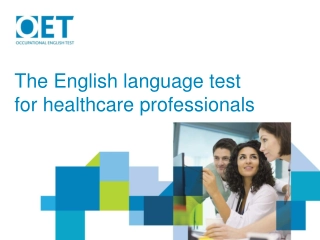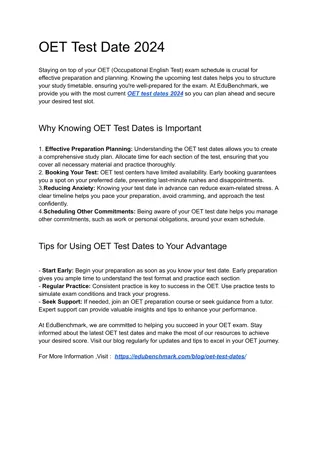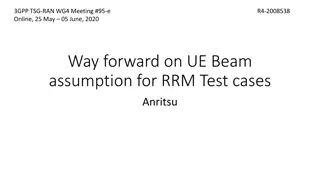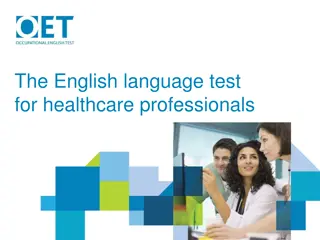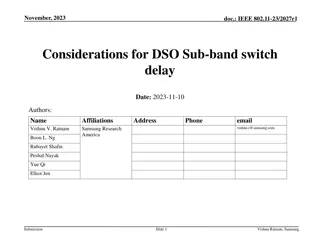GUIDE TO OET SPEAKING SUB-TEST
This guide provides essential tips for excelling in the OET Speaking Sub-Test, covering key points to remember, parts of the test, the interlocutor's role, and more. Learn how to approach the test confidently, interact with your interlocutor effectively, and navigate the different sections with ease. Prepare yourself for a successful performance on test day.
Download Presentation

Please find below an Image/Link to download the presentation.
The content on the website is provided AS IS for your information and personal use only. It may not be sold, licensed, or shared on other websites without obtaining consent from the author.If you encounter any issues during the download, it is possible that the publisher has removed the file from their server.
You are allowed to download the files provided on this website for personal or commercial use, subject to the condition that they are used lawfully. All files are the property of their respective owners.
The content on the website is provided AS IS for your information and personal use only. It may not be sold, licensed, or shared on other websites without obtaining consent from the author.
E N D
Presentation Transcript
GUIDE TO OET SPEAKING SUB-TEST Ms. Kirti Jani TESOL Certified Trainer
INTRODUCTION TO OET SPEAKING SUB-TEST This test assesses your ability to effectively communicate in a real-life context through the use of role plays. Profession specific role plays are provided for simulated consultation between a patient or healthcare practitioner. Candidate takes his/her professional role whereas an interlocutor takes a role of a patient or someone talking on behalf of patient such as carer or parent. Speaking test is of approximately 15-20 minutes.
POINTS TO REMEMBER Speaking test will be the last sub-test on the test day and I understand that you might be tired but remember your performance of the day will decide your future! 1) Be relaxed! Take deep breaths if you feel nervous. 2) It is not advisable to ask previous candidates about speaking topics or their performance because it is possible that they might have misunderstood the task and you are prone to enter the test room with same thoughts. It is also a part of malpractice. 3) Consider your interlocutor as your real patient and have natural conversation.
4) Do not worry because your interlocutor is neither your examiner nor medical professional; he/she is highly qualified and experienced English teacher, specifically trained for medical English. 5) Your speaking is assessed based on your voice, recorded during the test; therefore, wearing formal clothes, maintaining eye contacts, facial expressions, hand gestures etc. is not required. 6) This is not your knowledge test. You are expected to speak whatever you know about the task or make logical story when required. 7) You are not allowed to wear watch and there s no clock in speaking test room; however, the interlocutor will clearly guide you to start and stop the conversation. 8) Lastly and most importantly, be focused and confident!
PARTS OF SPEAKING TEST OET speaking sub-test is of four parts. 1. ID check 2. Warm-up session(not assessed) 3. First role play card(assessed) 4. Second role play card(assessed) Greeting the interlocutor: Once you enter the test-room, you should greet the interlocutor by wishing them, Good afternoon/evening. He/she may also respond to you. When he/she offers you the seat, say Thank you and then have a seat.
1. ID Check The interlocutor will ask you to provide your ID and will confirm your identity. He/she will verify the following details: Your name Candidate number Interviewer s name Interlocutor s number Role play card numbers Your profession Confirm your details on the declaration form and sign in.
2) Warm-up session(not assessed) In this part of your test, you will be asked questions about areas of professional interest, current or previous work experience, future plans etc. 3) First role-play (assessed) Interlocutor will provide you role-play card. You will be given 2-3 minutes to prepare for the task. Role-play is conducted for about 5 minutes. 4) Second role-play (assessed) The above procedure is repeated using the different role play.
EFFECTIVE UTILIZATION OF PREPARATION TIME 1) READ THE SETTING: Understand where the conversation is taking place. Assume yourself working in that area. 2) READ THE BACKGROUND INFORMATION AND IDENTIFY THE FOLLOWING DETAILS. Patient is known/unknown Reason of visit To whom you are talking(patient/relative) Age Medical condition and current concerns Emergency, if any Feelings( angry, upset, confused, frustrated and so on)
3) READ THE TASK: read what is assigned to you such as ask, explain, reassure, describe etc. Identify which points will take more time, for example- explanation takes more time than asking a question. Underline keywords. Your eyes will be moving through the role-play during conversation and underlined words will help you to form a question or respond immediately. Always be prepared with your introduction and first task to have smooth transition from introduction to the tasks.
NOTES: 1) If you do not understand the content of the role- play or how a role-play works, you are free to ask the interlocutor before the conversation begins. 2) If your patient is known to you, you may ask interlocutor s name during the preparation time and address the patient with the same name OR you may choose the name and take permission to address the patient with that name during the role-play.
TIPS FOR EFFICIENT CONVERSATION Based on the provided information, you should start the conversation. Following are the possible introduction: Unknown patient: My name s Kirti. I am one of the registered nurses/doctors on duty today. You look bit worried, could you please tell me what s bothering you? Known patient: Hello Mr. X! Nice to see you again. How are you feeling compared to your last visit? Maintain the chain of ask - listen and read respond ask Ask for information. Listen to your patient and read the next bullet point at the same time. Respond to your patient s concerns first. Ask next question.
understand that yours and interlocutors tasks are synchronized. It means when you have a question, the patient will have the answer and vice a versa. It should not be monotonous. Two-way communication should be achieved by asking an open-ended questions. Keep checking about patient s understanding after long explanation and important information. It s not mandatory to cover all the tasks; however, you should not waste much time discussing on one point. If time permits, summarize the conversation.
OET SPEAKING TASK ON COVID 19 ROLE-PLAY CARD NO 1 NURSING SETTING Home Visit Nurse You are talking to a 28-year-old patient who is uncooperative to undergo the rapid test for COVID 19. His/ her spouse is positive for corona test. Ask the patient to be investigated for covid 19. Introduce to available community services for family.( geriatric home, child care centers etc) Explain about the causes of covid 19(traveled/ living in an area with a widespread outbreak, close contact with someone positive), and likelihood of being positive. Ask what precautions he/she takes to protect herself/himself and any signs and symptoms (fever, cough, sore throat, SOB, tiredness etc) Convince the patient by explaining the reasons for investigation (spreading the disease to others, fatal if left untreated) Tasks
ROLE-PLAY CARD NO 1 NURSING Setting Home visit Patient A community health nurse is making a home visit to investigate you for COVID 19. You do not want to undergo the test because you are concerned about the care of your family members. Be reluctant when nurse persuades you to get investigated for COVID 19. (you are only the care taker, looking after kids and parents in the family) State that you are aware about risk of being positive still you do not want to know the diagnosis, believing that it will go away by itself. when asked, answer that you wear mask and gloves to protect yourself from infection and you just have some coughing and tiredness. Be hesitant to listen to the advice, but reluctantly agree only when the nurse explains that it s fatal for yourself and your family, if neglected. Tasks
Transcript Nurse: Good morning! My name s Kirti and I m a community health nurse. I ve been asked by your GP to make a home visit to perform rapid test for COVID 19 to make sure you have not been infected by your spouse. Patient: Well, I do not want to be tested for Corona. Nurse: Could you please tell me the reason for not being investigated? Patient: Because I am only the care taker of my husband/wife as well as my children and parents. So if the report turns positive then no- one will be available to take care of them. Nurse: I appreciate your concerns towards your family but you may receive help from the community services such as geriatric home or child care centre on temporary basis provided the report turns positive. See ..this is the area where the outbreak of corona is quite higher; additionally, you live with your husband/wife who is already affected, so I strongly recommend you to allow me to take the rapid test.
Patient: I know, I might be positive for covid 19 but I think its better not to know. Even if it s positive, it will fade-up by its own. Nurse: Okay! Before I proceed, I would like to ask you few questions to know about your well-being, May I? Patient: Yes please. Nurse: do you take any precautions to keep yourself safe from the infection? Patient: yes, I wear mask and gloves before entering my spouse s room for any reason and I also wash hands frequently. Nurse: that s the great things you do; however, you should wear PPT kit for safe side. Well .do you have any symptoms like .coughing, sneezing, throat pain, any breathing difficulty and so on? Patient: I don t have any major symptoms but sometimes I feel tired after some work and I also have slight coughing but I don t think so it s serious.
Nurse: Let me explain you that it is really necessary to get investigated as you have mild coughing and tiredness. If you really care for your family, you must confirm that you are safe from this disease or else you are at risk of spreading disease to all your family members including your little children. Finally, I am really sorry to have to tell you that COVID 19 is proven fatal, if left untreated. So I d like to request you to be tested for the same and sought treatment immediately if your fear turns true. Patient: I think you are right. If this disease cause death, I would like to see my family s and mine safety. Thank you for your visit and your explanation. Nurse: Thank you for taking my request into consideration. Let s hope for the best. If you have any concern now, please feel free to ask me.
KIRTI INSTITUTE MS. KIRTI JANI KIRTI INSTITUTE MS. KIRTI JANI TESOL CERTIFIED TRAINER Contact us on: +91 Email us on: kirti.oet@gmail.com Visit our website: www.kirtiinstitute.com TESOL CERTIFIED TRAINER Contact us on: +91- -7383111394 Email us on: kirti.oet@gmail.com Visit our website: www.kirtiinstitute.com 7383111394


